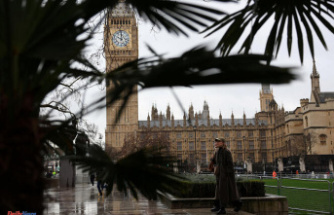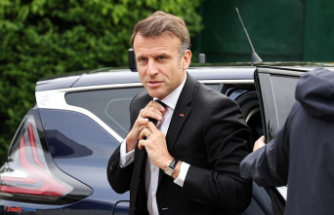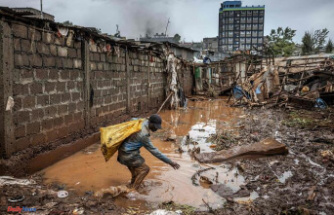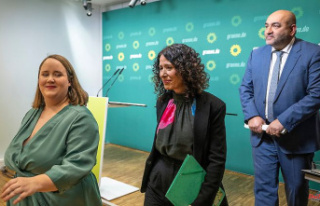The numbers do not speak a clear language after the election in Berlin. The CDU wins and yet there would still be a majority for red-green-red. But what does that mean now? Six lessons from an exciting election day.
1. This was a protest election
The CDU and its top candidate Kai Wegner deserve credit for celebrating after this election result. Winning the election with 28 percent is strong, no question. But the party should not confuse this success with the newly awakened love of Berliners. This election was primarily a protest election. Protest against having to vote again after 2021, protest against the fear of not being able to find an apartment or protest against the fact that you sometimes need a day off to make an appointment at the Citizens Registration Office. On the evening of the election, Governing Mayor Franziska Giffey emphasized several times that she was unable to solve all of these problems in a year and a half. Nevertheless, many voters must have thought of the SPD in all this. Because she has ruled the city for more than 20 years.
2. An era ends for the SPD in Berlin - for the CDU as well
The SPD regency since 2001, initially with Klaus Wowereit at the helm, then the rather pale Michael Müller, was not an easy legacy for Franziska Giffey. As nice as it may have been for a party to rule for so long at a time, mistakes kept piling up. The fact that the era of the SPD in the Red City Hall could be over was already announced in the last two elections. Giffey failed to break this downtrend. It is possible that she will continue to govern with the Greens and the Left. But in view of the success of the CDU, that would be difficult to convey. At the end there is the historically worst SPD result in Berlin.
It is precisely this success that marks the end of a two-decade journey through the desert for the CDU. Rows of their candidates were defeated by Wowereit, Müller and a year and a half ago Giffey. Incidentally, the beaming winner of this Sunday too: In September 2021, Kai Wegner only got 18 percent and thus slightly more than his predecessor in 2016. Nevertheless, everything is different now. The CDU won and in a convincing way. She's back in Berlin - even if the punished Senate still gets around 50 percent of the votes. Should Wegner find a coalition partner, he must make something of this leap of faith. Otherwise the next wave of protests could come and wash him out of the Rotes Rathaus.
3. The Greens are holding up well
Was that a successful evening for the Greens? On the one hand, they are the governing party that lost the least and are now level with the SPD. The distance to Giffey's party is only 105 votes. If the previous coalition continues its work, the Greens would gain more weight. It is also positive that, according to surveys, it could have been worse for the Greens. The fact is: The Greens voters stuck to their guns, the record result of 2021 was almost reached again. But Jarasch started with the aim of becoming governing mayor. That seems hopeless after the outcome of the election.
4. The FDP is finally in crisis, the left breathe deeply
What a blow for the FDP - the Liberals fail at the five percent hurdle and are no longer represented in the future House of Representatives. This is particularly bitter because they got 7.1 percent in the September 2021 election. This raises questions, the answer to which could also lie in Berlin. However, one floor higher, at the federal level. The FDP does not seem to get the traffic light coalition. It's the fifth election in a state to end with long faces. Saarland (missed to return), Schleswig-Holstein (kicked out of the government), North Rhine-Westphalia (kicked out of the government, result halved) and Lower Saxony (kicked out of the state parliament) ended badly. One thing is clear: for the Berlin FDP, it will be a tough three years until 2026 is re-elected.
The left, on the other hand, breathes deeply. At the federal level, it is teetering on the edge, but the stronghold of Berlin, or rather East Berlin, is standing. The good 12 percent is not a highlight, but as leading candidate Klaus Lederer said, it is good news for the party that Berlin remains stable while things look bleak elsewhere in the country. The Reds' greatest hope is now a new edition of Red-Green-Red or Green-Red-Red. Because there is no other perspective of power.
5. The AfD remains the AfD
This election also confirms that the AfD has established itself and will not disappear from the political landscape for the time being. The party, which is now largely right-wing extremist, gains around one percentage point. Notably, it didn't benefit more from the riots on New Year's Eve or from the city's other problems: inflation, high rents, or the admission of Ukrainian refugees. The AfD stays where it was. No more, no less.
6. The botched election was a blip
What would not be news elsewhere is in Berlin the most important thing of the evening in a way: the capital can organize elections after all. After the bankruptcy, bad luck and breakdown vote of September 2021, the matter went largely smoothly this time. The lack of trouble came at a price - €39m to be precise. Election workers received 240 euros for their efforts. Of which, however, fewer voters made a picture. Turnout dropped to 65 percent from 75.4 percent last time. But they didn't have to see that here and there a garbage can served as a ballot box or that the voting booth was made of cardboard. But hey, this is Berlin, right?!












